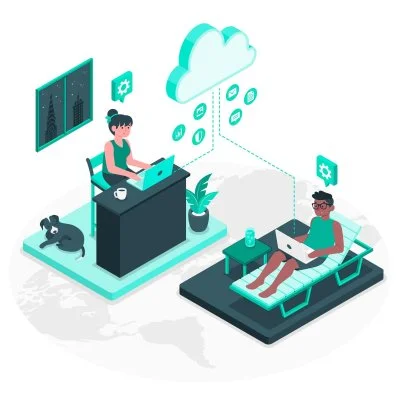Compliance can be complex in cloud environments, making the task even harder. If you need to move workloads between different regions, sometimes this isn't possible due to availability.
As part of your search process, assessing if a cloud service meets all your compliance requirements is necessary - this process can take time and be costly.
1. Know Your Regulatory Requirements
The first step of cloud compliance for businesses is identifying which laws and industry standards pertain to them. While shifting data storage to the cloud doesn't preclude compliance with regulations that dictate how it's managed (like privacy laws), this shift does alter how your data is managed, potentially impacting how it's stored/processed and can impact the ability to comply.
Your organization should also understand how it shares responsibility with its cloud service provider to comply with various laws that must be met. Most vendors use a shared responsibility model where infrastructure maintenance falls to them while customers must secure configurations of any services deployed on their platforms. The exact demarcation line depends on your choices of service and deployment model, such as opting for public cloud environments with multiple servers in different locations requiring your business to respect localization and sovereignty laws.

Once you understand which requirements must be fulfilled, the next step should be creating a strategy for remaining compliant. This typically involves implementing security controls such as encryption at rest and transit - however, for maximum protection, this must be appropriately implemented; recent incidents like Accenture's release of over one million voter records due to misconfiguration in Amazon S3 bucket demonstrate why good essential management practice must be put in place and maintained.
Another integral element of a cloud compliance strategy is classifying and organizing your data to protect better and manage it. This should include classifying personal and sensitive data into separate categories for easier management. In addition, policies around data access and deletion should also be put in place; consider setting need-based permissions that expire automatically for every category you store in the cloud.
Finally, you must ensure that your cloud environments have all the necessary certifications to remain compliant. This is particularly essential if conducting business with the federal government; typically, this means adhering to various federal standards as well as ISO 27001 certification if not. Otherwise, your business could face fines and reputational damage.
2. Implement Security Controls
Cloud technology enables organizations to scale up quickly to foster more innovation. However, as environments become increasingly complex and teams work across various technologies, having adequate security controls in place becomes even more essential to prevent breaches that expose sensitive information, impact operations continuity, or erode customer trust - damage that may take years to fix.
Not to worry, though; many of the same cybersecurity tools businesses already rely on can also assist them in meeting regulatory compliance. A security monitoring system, for instance, can flag any unusual activity - like users logging in from different locations or at unusual hours - and notify an organization's cybersecurity specialists so they can respond accordingly and stop breaches before they happen.
Other best practices for cloud security include encrypting data both in transit and at rest and restricting access to sensitive information with role-based security policies. Monitoring tools can assist businesses in tracking the security of their cloud environment and identifying any risks.
When choosing a service provider, they must offer robust inbuilt security protocols, meet industry standards like Cloud Security Alliance's Controls Matrix, and make available their compliance credentials which enable customers to assess security posture for deployments.
Understanding the shared responsibility model of cloud computing is also paramount, which divides security responsibilities between CSP and customer. This is especially applicable on public cloud platforms where CSP is responsible for infrastructure components while the customer is accountable for software applications and security controls used on that platform.
However, when businesses utilize private clouds instead, the division becomes more even between CSP and customers regarding infrastructure components and apps/data stored on that platform.
3. Monitor Your Cloud Environment
Cloud compliance varies significantly for every organization, as it depends on the industry you belong to and specific laws/regs/regulations which must be observed. For instance, companies which process credit card data must adhere to Payment Card Industry Data Security Standard (PCI-DSS) requirements.
However, these requirements can differ depending on a company's deployment model and service providers. For instance, software as a service (SaaS) and platform as a service (PaaS) environments have different needs than infrastructure as a service (IaaS) and storage as a service (SaaS).
An integral component of cloud compliance lies in monitoring your cloud environment to detect and respond to security threats using tools like security information and event management (SIEM). Encryption for both at-rest and transit data protects against SQL injection, cross-site scripting attacks and distributed denial of service attacks. At the same time, dormant accounts must also be closed down, along with credential and key management policies being implemented to prevent potential cyber security risks from emerging.
Maintaining an attentive view of your cloud architecture for any changes is also vital for troubleshooting performance and security issues as soon as they emerge. Doing this allows you to address problems before they become significant breaches quickly.
Monitor employee activity closely to protect the business and minimize risks posed by them. Specialized solutions can assist here as they allow you to track who accesses the cloud, when, and from which IP addresses. If an employee logs on outside regular working hours or from an unfamiliar IP address, this could indicate an imminent security breach and should be dealt with immediately.
By taking these measures, your business can easily comply with cloud computing standards and regulations, taking full advantage of all their benefits, including cost-cutting, disaster recovery and scalability. In addition, COVID-19 prompted many organizations to adopt remote work practices, which makes compliance even more essential than ever.
4. Perform Regular Audits
Maintaining compliance standards can be an immense task that often demands significant resources. Furthermore, as laws and regulations evolve and change over time, so must practices within an organization adapt to meet new criteria set by regulators.
If you are choosing a cloud service provider, ensure it meets all current regulatory standards for data protection. Otherwise, the risk is too significant that sensitive information will fall into the wrong hands and fines or even closure could ensue.
Auditing your cloud environment regularly is also key for maintaining its health. Doing this will allow you to identify potential issues and mitigate risks while uncovering cost savings opportunities. For instance, storing large volumes of data on one virtual machine can incur unnecessary expenses as you'll pay for more capacity than required.
An effective cloud audit requires engaging an independent third party to assess your cloud provider's level of compliance and identify any potential gaps. The audit may include scoping processes, an on-site visit, gathering evidence and producing a report.
The audit report will contain recommendations the organization can implement to comply with relevant regulatory standards while management assigns tasks and takes necessary actions based on those recommendations.
Executing regular audits can help businesses reduce the risks and penalties of noncompliance with applicable regulatory bodies and laws, implement security controls, monitor their cloud environment, ensure they meet requirements set out by regulatory bodies/laws/regulations and utilize a cloud services provider renowned for reliability/quality service (i.e. one with multiple data centers around the world to facilitate faster access).
